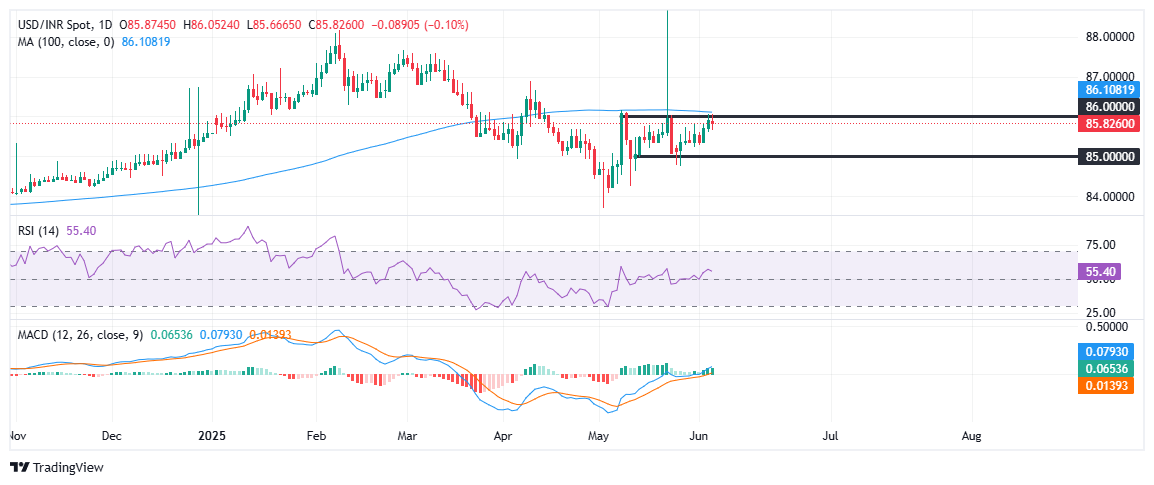Created
: 2025.06.05














![]() 2025.06.05 21:29
2025.06.05 21:29
The Indian Rupee (INR) strengthens modestly against the US Dollar (USD) on Thursday, ending a two-day losing streak as the Greenback softened following Wednesday's weaker-than-expected US economic data. At the time of writing, USD/INR is trading near 85.80, down from the intraday high of 86.05, and remains confined within Wednesday's range. The modest Rupee gains are supported by a pullback in the US Dollar and stable Crude Oil prices.
On the equity front, Indian stocks posted mild gains, further boosting sentiment. The BSE Sensex rallied 444 points to close at 81,442, while the NSE Nifty advanced 131 points to finish at 24,751. The risk-on tone in equities lent additional support to the Rupee, easing concerns over capital outflows and reinforcing expectations of continued foreign inflows.
All eyes are now on the RBI's monetary policy announcement, scheduled for Friday. Markets widely anticipate a 25-basis-point rate cut -- the third consecutive reduction -- amid easing inflation and the central bank's push to support growth momentum. The outcome could play a key role in shaping the near-term direction for the INR.
The USD/INR pair remains stuck in a tight range, with price action consolidating between key support at 85.00 and resistance near the 86.00 handle. Thursday's pullback from the intraday high of 86.05 highlights the pair's failure to sustain upside momentum, keeping it pinned below the 100-day Simple Moving Average (SMA) at 86.10.
Momentum indicators suggest a neutral to slightly bullish bias. The Relative Strength Index (RSI) holds above the 50 mark at 55.12, indicating modest bullish strength without signaling overbought conditions. Meanwhile, the Moving Average Convergence Divergence (MACD) histogram remains positive, with a fresh bullish crossover suggesting buying interest could return if the pair clears 86.10 decisively. Until then, USD/INR is likely to stay rangebound, with traders eyeing upcoming US data and the RBI decision for breakout cues.

The role of the Reserve Bank of India (RBI), in its own words, is "..to maintain price stability while keeping in mind the objective of growth." This involves maintaining the inflation rate at a stable 4% level primarily using the tool of interest rates. The RBI also maintains the exchange rate at a level that will not cause excess volatility and problems for exporters and importers, since India's economy is heavily reliant on foreign trade, especially Oil.
The RBI formally meets at six bi-monthly meetings a year to discuss its monetary policy and, if necessary, adjust interest rates. When inflation is too high (above its 4% target), the RBI will normally raise interest rates to deter borrowing and spending, which can support the Rupee (INR). If inflation falls too far below target, the RBI might cut rates to encourage more lending, which can be negative for INR.
Due to the importance of trade to the economy, the Reserve Bank of India (RBI) actively intervenes in FX markets to maintain the exchange rate within a limited range. It does this to ensure Indian importers and exporters are not exposed to unnecessary currency risk during periods of FX volatility. The RBI buys and sells Rupees in the spot market at key levels, and uses derivatives to hedge its positions.
![]()
Created
: 2025.06.05
![]()
Last updated
: 2025.06.05

FXStreet is a forex information website, delivering market analysis and news articles 24/7.
It features a number of articles contributed by well-known analysts, in addition to the ones by its editorial team.
Founded in 2000 by Francesc Riverola, a Spanish economist, it has grown to become a world-renowned information website.
We hope you find this article useful. Any comments or suggestions will be greatly appreciated.
We are also looking for writers with extensive experience in forex and crypto to join us.
please contact us at [email protected].
Disclaimer:
All information and content provided on this website is provided for informational purposes only and is not intended to solicit any investment. Although all efforts are made in order to ensure that the information is correct, no guarantee is provided for the accuracy of any content on this website. Any decision made shall be the responsibility of the investor and Myforex does not take any responsibility whatsoever regarding the use of any information provided herein.
The content provided on this website belongs to Myforex and, where stated, the relevant licensors. All rights are reserved by Myforex and the relevant licensors, and no content of this website, whether in full or in part, shall be copied or displayed elsewhere without the explicit written permission of the relevant copyright holder. If you wish to use any part of the content provided on this website, please ensure that you contact Myforex.
Myforex uses cookies to improve the convenience and functionality of this website. This website may include cookies not only by us but also by third parties (advertisers, log analysts, etc.) for the purpose of tracking the activities of users. Cookie policy